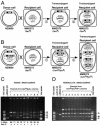Conjugative transfer of the Lactococcus lactis chromosomal sex factor promotes dissemination of the Ll.LtrB group II intron
- PMID: 15659671
- PMCID: PMC545711
- DOI: 10.1128/JB.187.3.930-939.2005
Conjugative transfer of the Lactococcus lactis chromosomal sex factor promotes dissemination of the Ll.LtrB group II intron
Abstract
The Ll.LtrB group II intron from the low-G+C gram-positive bacterium Lactococcus lactis was the first bacterial group II intron shown to splice and mobilize in vivo. This retroelement interrupts the relaxase gene (ltrB) of three L. lactis conjugative elements: plasmids pRS01 and pAH90 and the chromosomal sex factor. Conjugative transfer of a plasmid harboring a segment of the pRS01 conjugative plasmid including the Ll.LtrB intron allows dissemination of Ll.LtrB among L. lactis strains and lateral transfer of this retroelement from L. lactis to Enterococcus faecalis. Here we report the dissemination of the Ll.LtrB group II intron among L. lactis strains following conjugative transfer of the native chromosomally embedded L. lactis sex factor. We demonstrated that Ll.LtrB dissemination is highly variable and often more efficient from this integrative and conjugative element than from an engineered conjugative plasmid. Cotransfer among L. lactis strains of both Ll.LtrB-containing elements, the conjugative plasmid and the sex factor, was detected and shown to be synergistic. Moreover, following their concurrent transfer, both mobilizable elements supported the spread of their respective copies of the Ll.LtrB intron. Our findings explain the unusually high efficiency of Ll.LtrB mobility observed following conjugation of intron-containing plasmids.
Figures




Similar articles
-
Restriction for gene insertion within the Lactococcus lactis Ll.LtrB group II intron.RNA. 2006 Nov;12(11):1980-92. doi: 10.1261/rna.193306. Epub 2006 Sep 14. RNA. 2006. PMID: 16973892 Free PMC article.
-
Conjugative transfer of the Lactococcus lactis sex factor and pRS01 plasmid to Enterococcus faecalis.FEMS Microbiol Lett. 2007 Apr;269(2):289-94. doi: 10.1111/j.1574-6968.2007.00641.x. Epub 2007 Jan 30. FEMS Microbiol Lett. 2007. PMID: 17263841
-
Trans-splicing of the Ll.LtrB group II intron in Lactococcus lactis.Nucleic Acids Res. 2007;35(7):2257-68. doi: 10.1093/nar/gkl1146. Epub 2007 Mar 27. Nucleic Acids Res. 2007. PMID: 17389638 Free PMC article.
-
Group II introns and expression of conjugative transfer functions in lactic acid bacteria.Antonie Van Leeuwenhoek. 1999 Jul-Nov;76(1-4):77-88. Antonie Van Leeuwenhoek. 1999. PMID: 10532373 Review.
-
Bacterial group II introns and their association with mobile genetic elements.Front Biosci. 2002 Aug 1;7:d1843-56. doi: 10.2741/klein1. Front Biosci. 2002. PMID: 12133822 Review.
Cited by
-
Conjugation across Bacillus cereus and kin: A review.Front Microbiol. 2022 Nov 4;13:1034440. doi: 10.3389/fmicb.2022.1034440. eCollection 2022. Front Microbiol. 2022. PMID: 36406448 Free PMC article. Review.
-
Survey of group I and group II introns in 29 sequenced genomes of the Bacillus cereus group: insights into their spread and evolution.Nucleic Acids Res. 2008 Aug;36(14):4529-48. doi: 10.1093/nar/gkn372. Epub 2008 Jun 28. Nucleic Acids Res. 2008. PMID: 18587153 Free PMC article.
-
Group II Introns Generate Functional Chimeric Relaxase Enzymes with Modified Specificities through Exon Shuffling at Both the RNA and DNA Level.Mol Biol Evol. 2021 Mar 9;38(3):1075-1089. doi: 10.1093/molbev/msaa275. Mol Biol Evol. 2021. PMID: 33118013 Free PMC article.
-
Dispersion of the RmInt1 group II intron in the Sinorhizobium meliloti genome upon acquisition by conjugative transfer.Nucleic Acids Res. 2007;35(1):214-22. doi: 10.1093/nar/gkl1072. Epub 2006 Dec 7. Nucleic Acids Res. 2007. PMID: 17158161 Free PMC article.
-
Restriction for gene insertion within the Lactococcus lactis Ll.LtrB group II intron.RNA. 2006 Nov;12(11):1980-92. doi: 10.1261/rna.193306. Epub 2006 Sep 14. RNA. 2006. PMID: 16973892 Free PMC article.
References
-
- Belfort, M., V. Derbyshire, M. M. Parker, B. Cousineau, and A. M. Lambowitz. 2002. Mobile introns: pathways and proteins, p. 761-783. In N. L. Craig, R. Craigie, M. Gellert, and A. M Lambowitz (ed.), Mobile DNA II. ASM Press, Washington, D.C.
-
- Belfort, M., K. Ehrenman, and P. S. Chandry. 1990. Genetic and molecular analysis of RNA splicing in Escherichia coli. Methods Enzymol. 181:521-539. - PubMed
-
- Belhocine, K., I. Plante, and B. Cousineau. 2004. Conjugation mediates transfer of the Ll.LtrB group II intron between different bacterial species. Mol. Microbiol. 51:1459-1469. - PubMed
-
- Burrus, V., G. Pavlovic, B. Decaris, and G. Guédon. 2002. Conjugative transposons: the tip of the iceberg. Mol. Microbiol. 46:601-610. - PubMed
-
- Cousineau, B., D. Smith, S. Lawrence-Cavanagh, J. E. Mueller, J. Yang, D. Mills, D. Manias, G. Dunny, A. M. Lambowitz, and M. Belfort. 1998. Retrohoming of a bacterial group II intron: mobility via complete reverse splicing, independent of homologous DNA recombination. Cell 94:451-462. - PubMed
Publication types
MeSH terms
LinkOut - more resources
Full Text Sources

